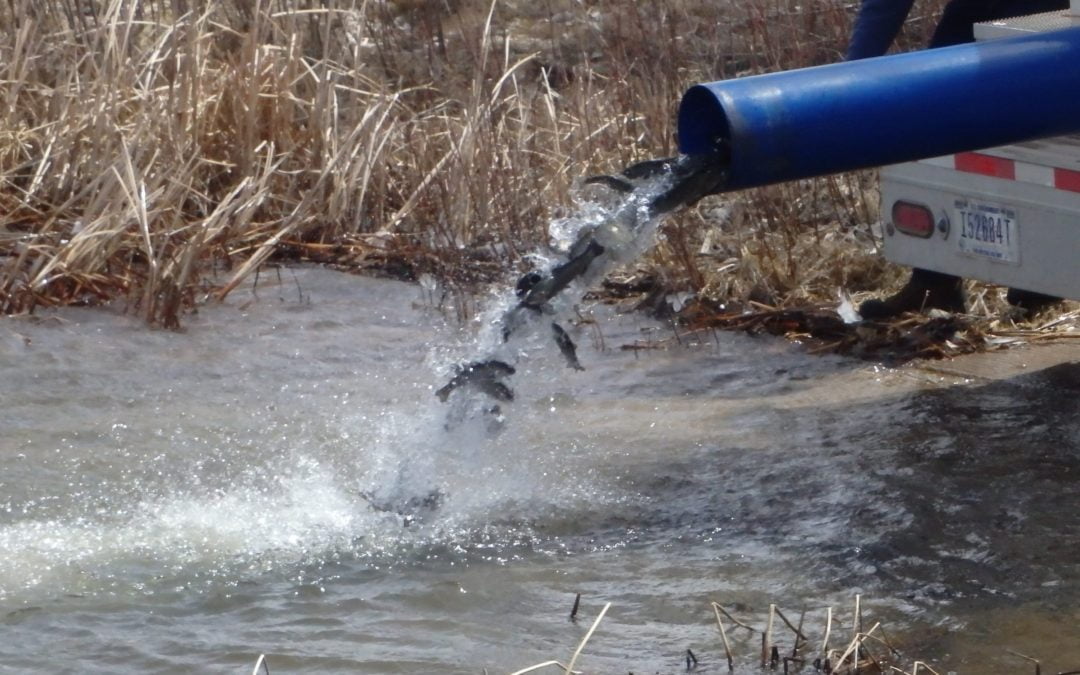
by Winston Rods | May 5, 2021
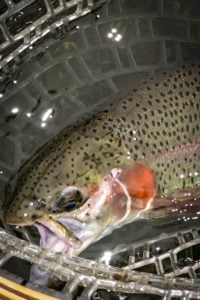 By James Joiner
By James Joiner
Somewhere past the half-way mark of every Cape Cod winter the day comes where anglers collectively – often subconsciously – decree it time to return to more temperate habits. Rods and reels are assembled. Piles of flies crusted together under the guise of forgotten winter organizational projects get separated into trash and not. Waders are timidly tested in private to see if the past few month’s overindulgences caused any shrinkage. Group texts circulate as fairer-weather friends shake off social cobwebs and perform a loose headcount.
The snow is usually gone, ground sucking with mud, ice receded enough for returning osprey to find food. While Cape Cod is surrounded by ocean, it’s not salt water that rouses us from winter’s hibernatorial distractions. No, this is a time to look inward, toward the 996 ponds haphazardly scattered across our 90-mile man-made island. Left behind by the last ice age, these freshwater ‘kettle holes’ range in size from ‘damn, that’s a lot of water’ to “even ___ could cast across it” and, once the truck trout* arrive, they’re filled to the gills with ego-floatingly easy to catch stocked fish.
Growing up, we’d start checking freshwater beaches for the telltale tire tracks of tanker trucks backing in as soon as the sand stopped being hard enough to skateboard on. In modern times, the only legwork involved in figuring out when and where freshly delivered fish can be found is checking the state’s stocking report website, which gives up dates, locations, and fish type. I’m certain there are more adventurous souls who dislike such convenience, but personally I find it motivates me more than driving from pond to pond peering for signs of life. I prefer to save my audaciousness for bigger game, such as the striper migration’s arrival, only a month or two away at this point.
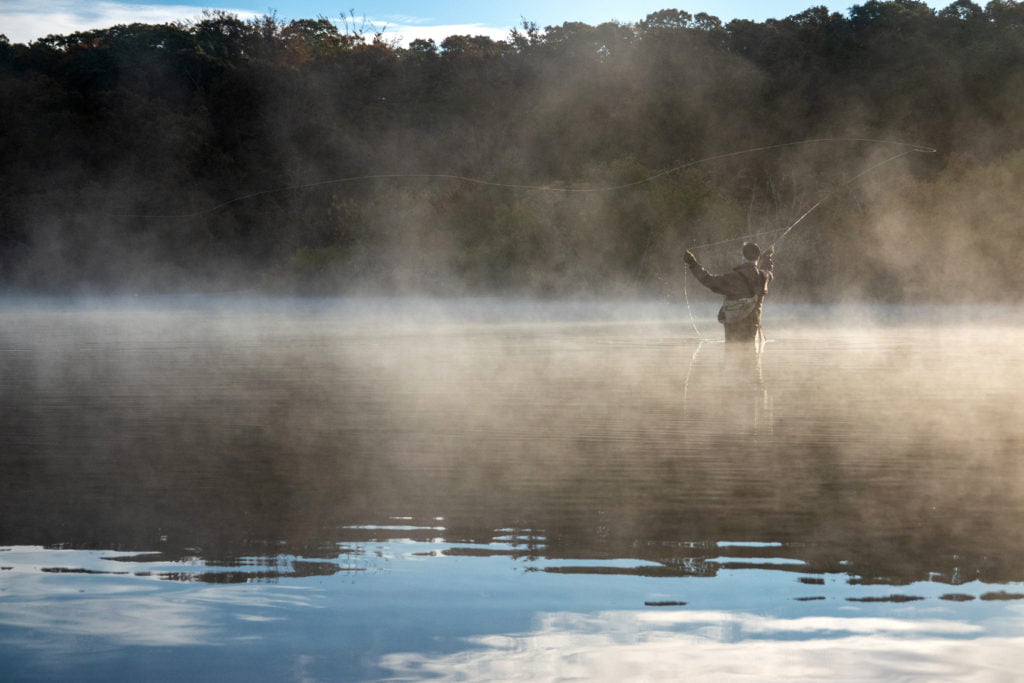
Notably naïve, stocked fish are easier prey than their more seasoned counterparts who wisely remain in deeper water while Powerbait and Woolie Buggers rain from the sky and thin the newly arrived herd. Growing up in a concrete tank with constant food and zero competition doesn’t do much to prepare these truck trout for Darwinian survival in the wild, a fact appreciated and taken advantage of by the army of local anglers, conventional and otherwise, who descend upon them. I like to imagine my own catch-and-release practice to be a crash course in pond-level street smarts, trading cheap thrills for sore lips and a life lesson in looking before you eat.
Regardless, it’s a great and time-honored way to get the casting arm back. It also helps keep my aging fingers nimble enough to tie knots while on the water, far more rewarding than doing so drunkenly in front of a Seinfeld marathon. Admittedly many of the bait fishermen, hidden behind their thick hedges of rods balanced on forked sticks and in PVC pipes, do bear an uncanny resemblance to certain eccentric cast members.
Even as barbless hooks train truck trout to survive in the wild, the admittedly easy hunt for them reignites an angling obsession that can be hard to maintain through New England’s long, dark, hermit-like winters. Sure, I keep up on blogs and magazines and, when I can, take a trip or two to try my luck in warmer climes. But truck trout are the pre-season training that get the mind and body ready for the rigors of striper season. Early mornings, late nights, missed meetings, estranged families – these become the norm as summer wears on through fall and single-mindedness drives us repeatedly to the sea in search of schoolies and larger. It’s a compulsion that will drive you crazy, though often just as you’re about to lose your last wit the season ends, the ocean once again grey, cold, and devoid of life until next year. Yeah, some of us drag it out long into the winter, but as weeks stretch into months without a sign of anything but frostbite the fire subsides and normal life returns, if only for a little while.
*Thanks @fish_fiends for the turn of phrase.
by Winston Rods | Nov 18, 2020
By Glenn K Chen
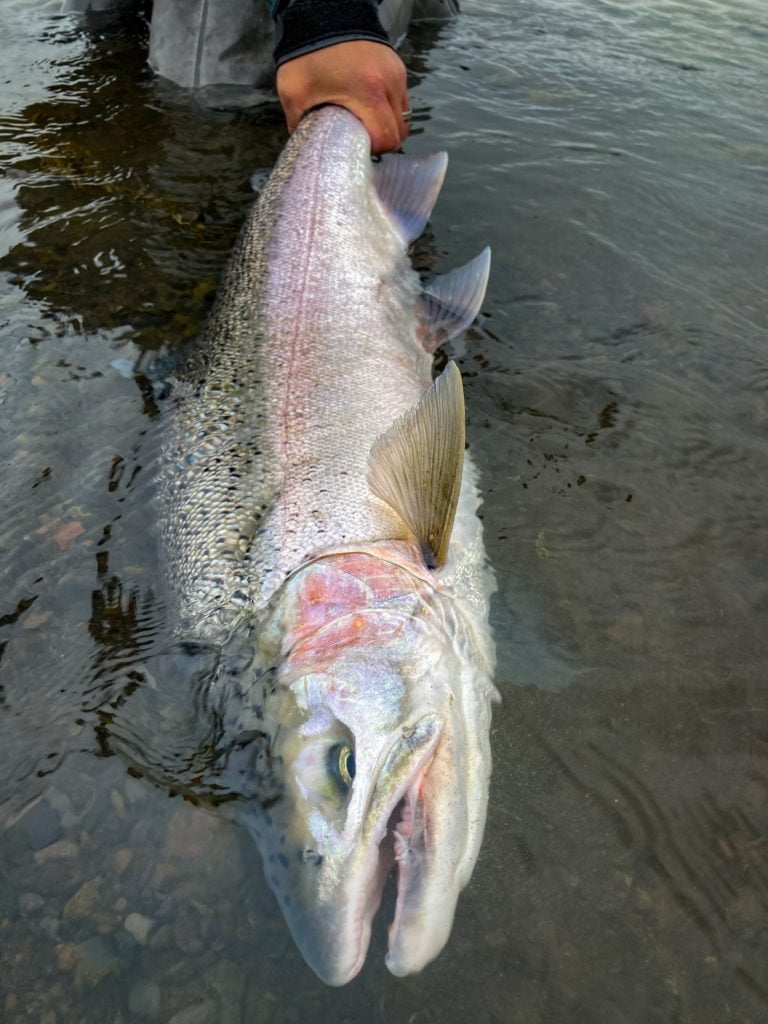 As a resident of the Great North since the early 2000’s, I’ve endured nearly two decades of long, dark, and frigid winters for those few brief months of fair-weather angling glory. From the onset of the midnight sun in late May through the fierce storms of October, anadromous salmonids are the focus of my annual pursuits in Alaska, and while I savor the opportunity to catch any species from the Pacific salmon clan, it’s the steelhead — among all members of the genus Oncorhynchus — that occupies a most special place in my angling soul.
As a resident of the Great North since the early 2000’s, I’ve endured nearly two decades of long, dark, and frigid winters for those few brief months of fair-weather angling glory. From the onset of the midnight sun in late May through the fierce storms of October, anadromous salmonids are the focus of my annual pursuits in Alaska, and while I savor the opportunity to catch any species from the Pacific salmon clan, it’s the steelhead — among all members of the genus Oncorhynchus — that occupies a most special place in my angling soul.
My fly fishing endeavors were hampered by a debilitating paralysis in my 20’s, which left me with very limited casting abilities using a single hand rod, and I thus angled for “steel fish” with conventional gear during most of the subsequent decades. While I did acquire a Spey outfit along the way, I really struggled with the unfamiliar setup — until I encountered a talented young guide named Trevor Covich. During one of my wilderness Alaska angling adventures, Trevor took me under his tutelage, and patiently helped me to learn the intricacies of both Spey casting and swing fishing. The two-handed rod has thus enabled me to overcome my physical handicap, and to enjoy once again pursuing my favorite species with tackle that I have not been able to use for many years.
The Winston two-handers are the ones I choose whenever I’m chasing Alaska steelhead. These rods have the ideal combination of flex needed to sense proper loading during the cast, followed by terrific power to send the fly to a distant holding lie on the forward stroke. (I also find their actions to be quite forgiving regarding casting faux pas, which is a blessing when my abilities decline after a long day’s effort.) Their outstanding durability is a really big plus as well, especially when you’re fishing in a remote spot where you’re limited with regards to the amount of gear you can bring — and where obtaining a replacement rod is nigh impossible.

Here on the Kenai Peninsula where I reside, the 11’ 6” Winston 6-weight rod is ideal for swing fishing steelies in our local, moderate-sized streams. For the larger and swifter rivers elsewhere in Alaska, I select the 13’ 3” models: rigged with Skagit heads and T8 or T11 sink tips, these longer rods enable me to effectively cover the myriad of angling conditions that are present in such systems.
This October, I was fortunate to once again venture to remote Alaska in pursuit of Oncorhynchus mykiss, and my Winston 13’ 3” 7-weight two-handers were again the rods I fished with on this weeklong adventure. As usual, we encountered both sunshine and light breezes, as well as driving rain with howling winds that nearly toppled me in the water — and these rods handled the adverse conditions with aplomb. Many of the steelhead fought with wild abandon, repeatedly leaping high and running far downstream, and really straining my tackle before surrendering reluctantly to a skillfully wielded net. The Winstons performed flawlessly during the entire trip, and accounted for dozens of out-sized steel fish (with stout girths) up to 35 inches in length
My final hookup resulted in my most memorable catch of the visit. I had just released a chrome-bright 32-inch hen that had jumped 12 times in succession during a lengthy fight that took me repeatedly into my reel’s backing. After releasing her, I continued to cast and wade down the underwater mid-river gravel bar, until I reached a spot where another step would submerge me too deeply. Making sure that my feet were firmly planted, I sent the fly towards the shoreline trees, and lowered the tip of my 13’ 3” Winston 7-weight as it began to swing. The savage strike occurred within seconds, nearly teetering me into the swift current as the unseen fish tore off downstream in a furious run. Fifty, then a hundred and then 200 yards of backing instantly disappeared, and I applied intense pressure in an attempt to halt this mad dash. For a few seconds, the steelhead held fast, angry head shakes telegraphed all the way up into the throbbing rod as it attempted to dislodge the offending hook – then the brief détente ceased, and my reel began screaming again as the remaining backing melted off the big Hardy Bougle.
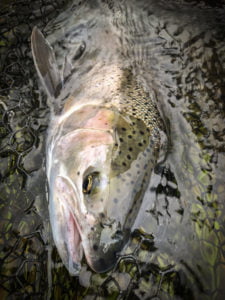 As I was stranded in the middle of the river and thus unable to follow the fish, I yelled to our guide for assistance. Much to my relief, Garrett quickly arrived with the boat, and I tumbled in with less than 40 yards of backing remaining on the spool. We then chased the swiftly vanishing steelhead, steadily rewinding while keeping a deep bend in the rod, for seemingly endless minutes. When the running line eventually reached the tip top, we beached the boat – only to have my quarry tear off in more astonishing runs far downstream that took away much of my hard won effort.
As I was stranded in the middle of the river and thus unable to follow the fish, I yelled to our guide for assistance. Much to my relief, Garrett quickly arrived with the boat, and I tumbled in with less than 40 yards of backing remaining on the spool. We then chased the swiftly vanishing steelhead, steadily rewinding while keeping a deep bend in the rod, for seemingly endless minutes. When the running line eventually reached the tip top, we beached the boat – only to have my quarry tear off in more astonishing runs far downstream that took away much of my hard won effort.
This amazing steel fish wouldn’t give up, never rolling over as it dashed away repeatedly in spite of Garrett’s extra cautious attempts to approach it again and again with a landing net. He then decided that extreme stealth would be required to outwit the steelhead, so he crouched as low as possible, well below of me, and kept the net outstretched and motionless atop the substrate. After more tense and anxious moments, when the steelie would repeatedly veer away at the last second, I somehow managed to finally lead it gently into the waiting meshes – and whooped in sheer exultation when the 31-inch super hen was captured. Upon release, she immediately dashed away with amazing vigor, seemingly impervious to her lengthy struggle against modern angling technology. Truly, she was a supreme athlete among steelhead, and I hope that her indomitable genes will be forever passed on to future generations.
Glenn K Chen is a Winston enthusiast living in Alaska and enjoys all things two-hand.
by Winston Rods | Nov 13, 2020
November 2020
Twin Bridges, Montana

These beautiful new ultralight and soft technical hooded fishing shirts are designed to hang untucked with a generous fit. Made with 100% performance water-wicking 30+ UPF (Ultraviolet Protection Factor) polyester fabric, these shirts are our most recent edition to our TROUT TECH Conservation accessories and are perfect for a sunny day on the water!
(more…)
by R.L. Winston Rod Company | Oct 21, 2020
By TC Valentine

Vaughn’s Salon- Catalina Island, 8:03 AM PST. In only 80 feet of marine blue water clear enough to see rock formations, yellow kelp forest and aqua green shadows lurking- the Hummingbird fish finder shows big red marks. “Yellowtail under the boat.” Growing up in southern California is wonderful but the eastern sierra mountains are 6 hours away. Trout fishing remains my passion, but the big blue Pacific Ocean is out my front door. With a little more opportunity to fish in the ocean, we have made the switch. Now, we fish trout and salt. (more…)
by Winston Rods | Sep 25, 2020
September 2020
Twin Bridges, MT

The Winston Rod Company, manufacturer of the world’s finest fly rods and located in Twin Bridges, Montana, announced their new TROUT TECH T-shirt collection today.
(more…)
by Winston Rods | Sep 1, 2020
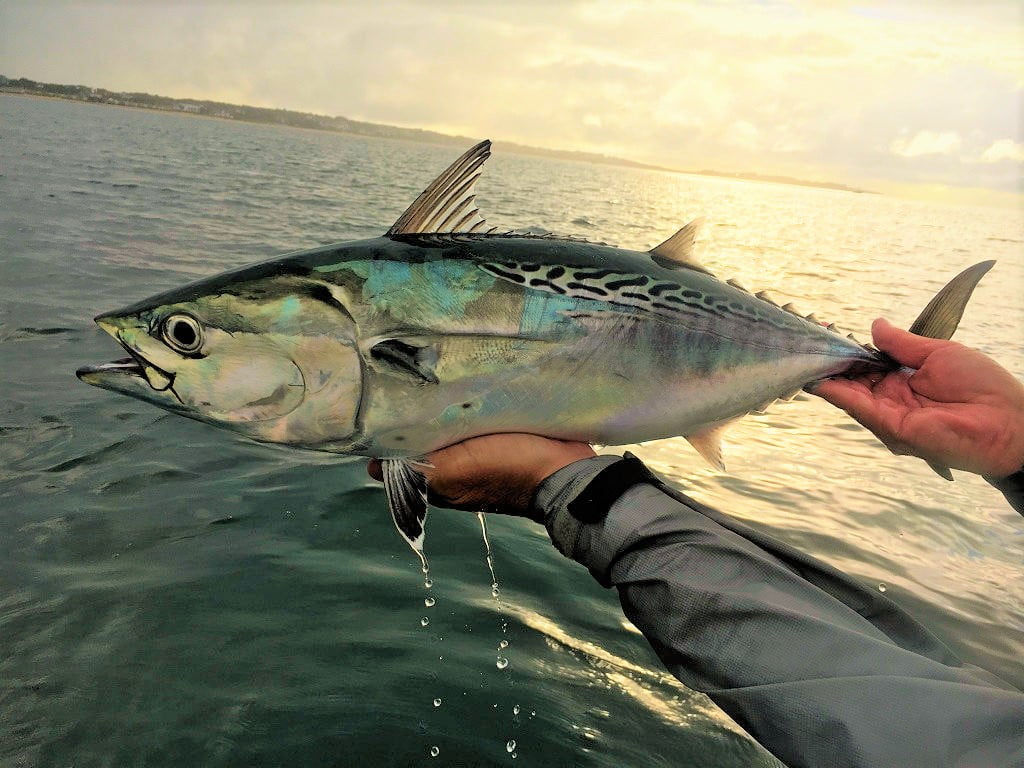
“A rocket strapped to a football,” is the best way I’ve head false albacore described. Sure, it sounds a bit exaggerated, but a false albacore’s ability to put on a speed show is unrivaled by many other comparable game fish. The explosive blitzes and readiness to eat flies, make false albacore a fly angler’s dream. When hooked, one should expect a very fast run that almost always peels dozens of yards into the backing. While “albies” will not showcase the same power as their larger tuna cousins, they’re still plenty of fun on a 9 or 10 weight. (more…)
by Winston Rods | Jul 27, 2020

TROUTSCHOOL TROUTGAITERS:(Available Backgrounds:Peach,Light Green,Light Blue, Pink) (Fish by James Prosek)
The Winston Rod Company, leading manufacturer of premium trout and saltwater fly rods, located in Twin Bridges, Montana, today announced an additional four new TROUTGAITER designs under it’s flyfishing accessories program, bringing the total to nine new TROUTGAITER designs under its new accessories program this summer.According to Winston Customer Service Representative, Sawyer Keener, “These four ‘trout school’ designs are the culmination of the summer’s new TROUTGAITER program.They feature a beautiful tight repeating pattern of James Prosek’s paintings of brown, cutthroat and golden trout against a variety of light backgrounds from paintings specifically commissioned for us by James over the past two decades. The patterns used were inspired by James’ current Art,Artifact, Artifice exhibition at the Yale University Art Gallery (https://artgallery.yale.edu/publication/james-prosek-art-artifact-artifice) in new Haven, CT. ”Winston now offers nine new TROUTGAITERS, six of which incorporate the artwork of James Prosek. As noted previously, Prosek donated the use of his artwork and, together with Winston and Bauer, we have donated to Trout Unlimited in Montana to support important local conservation initiatives.The new TROUTGAITERS are available for order now at Winston and Bauer dealers everywhere, and at winstonrods.com and bauerflyreel.com.
The other New WINSTON TROUTGAITERS™available now are:

You’re Going to Need a Bigger Net

Golden Trout
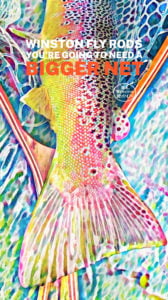
You’re Going to Need a Bigger Net
The other New BAUER TROUTGAITERS™available now are:

Bauer Blue

Bauer Colorful Reels
To purchase any TROUTGAITER, contact your favorite Winston Dealer or Purchase directly from winstonrods.com.
TROUTGAITERSTM, are intended to be used primarily as neck gaiters. Like many neck gaiters, they are not intended to replace medical grade respirator masks, or other masks, to prevent the transmission of illnesses.
by Winston Rods | Jul 22, 2020

With all the travel I do there’s not as much time to fish at home here in Idaho like back in my trout bumming days. It’s weird but it’s a truth to the way my life has become. And although there are no complaints about getting to fish unique places for many cool fish species, I do miss fishing at home. Therefore, when I am in Idaho, I make dang sure my most needed Winston’s are always loaded in the Explorer ready to go.
(more…)
by Winston Rods | Jul 16, 2020

July 2020
Twin Bridges, MT
The Winston Rod Company, located at the convergence of the Beaverhead, Big Hole, Ruby and Jefferson Blue Ribbon Trout Rivers in Southwestern Montana, today announced an additional three new TROUTGAITERTM designs as part of it’s flyfishing accessories program. Bringing the total to five, these beautiful face and neck coverings provide stunning new styles and colors for your face mask/gaiter collection.

(more…)
by Winston Rods | Jul 7, 2020

WINSTON “Not Recommended” TROUTGAITERTM

BAUER REELS Colorful Reels TROUTGAITERTM
The Winston Rod Company, located in the heart of wild trout fishing in Southwestern Montana, today announced the first of its new TROUTGAITERSTM designs as part of it’s flyfishing accessories program. These face and neck coverings provide a colorful addition to your face covering/gaiter collection while fishing, hiking or for a variety of activities. The beautiful new designs utilize a trout-themed approach to wearing neck gaiters. In fact, several of the new TROUTGAITERSTM incorporate the spectacular trout paintings of celebrated artist James Prosek. James donated the use of his artwork, and together with Winston and Bauer, we donated to Trout Unlimited in Montana to help with TU’s important coldwater conservation efforts.
(more…)

 By James Joiner
By James Joiner





 As I was stranded in the middle of the river and thus unable to follow the fish, I yelled to our guide for assistance. Much to my relief, Garrett quickly arrived with the boat, and I tumbled in with less than 40 yards of backing remaining on the spool. We then chased the swiftly vanishing steelhead, steadily rewinding while keeping a deep bend in the rod, for seemingly endless minutes. When the running line eventually reached the tip top, we beached the boat – only to have my quarry tear off in more astonishing runs far downstream that took away much of my hard won effort.
As I was stranded in the middle of the river and thus unable to follow the fish, I yelled to our guide for assistance. Much to my relief, Garrett quickly arrived with the boat, and I tumbled in with less than 40 yards of backing remaining on the spool. We then chased the swiftly vanishing steelhead, steadily rewinding while keeping a deep bend in the rod, for seemingly endless minutes. When the running line eventually reached the tip top, we beached the boat – only to have my quarry tear off in more astonishing runs far downstream that took away much of my hard won effort.














